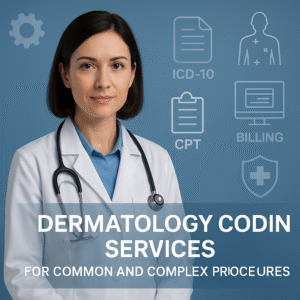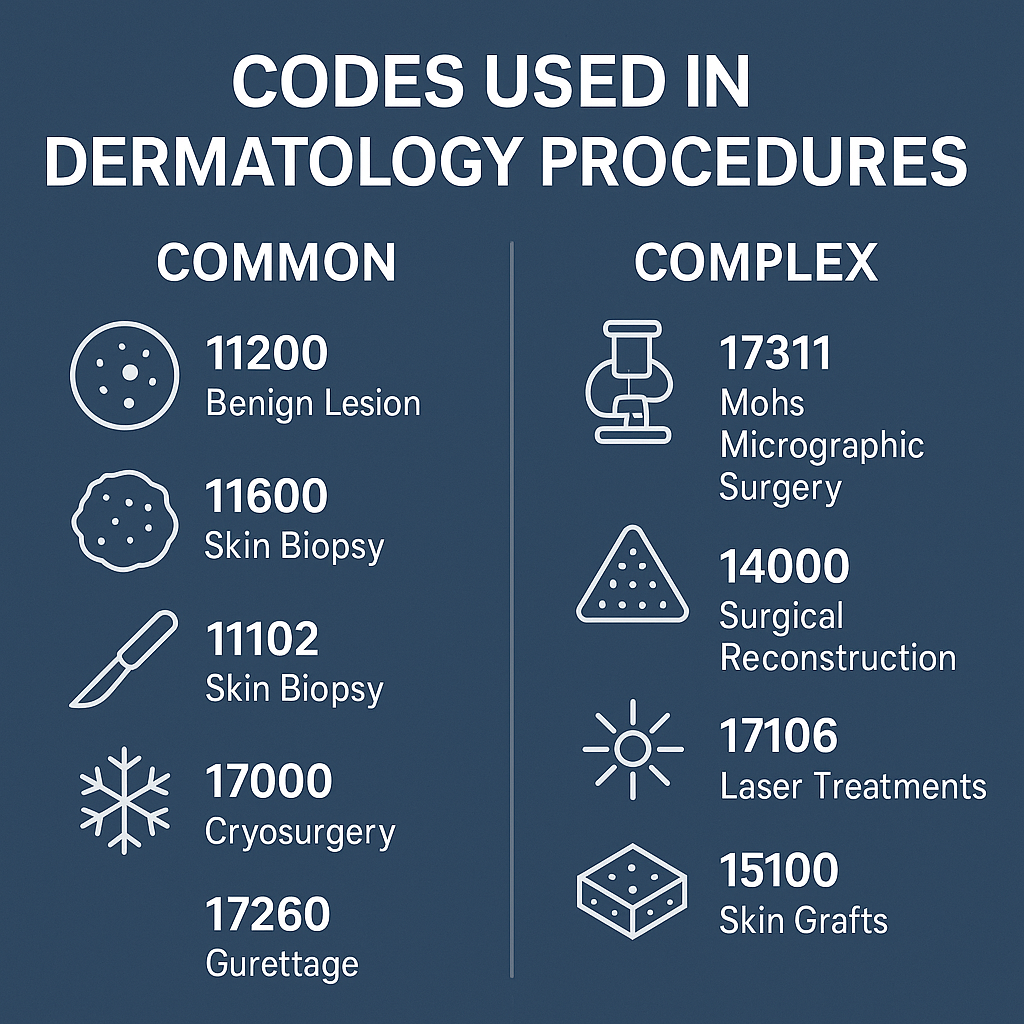Dermatology Coding Services
Dermatology Coding
Dermatology Coding . Complete Guide for Common and Complex Procedures
Maximize your dermatology practice revenue with precision coding for CPT, ICD-10, and billing compliance
📋 Table of Contents
🎯 Why Dermatology Coding Matters
Dermatology practices face unique coding challenges that can significantly impact revenue and compliance. Unlike other specialties, dermatologists perform multiple procedures during single visits, often combining diagnostic, therapeutic, and surgical services.

Key reasons why precision coding is critical:
- Revenue optimization: Proper coding ensures maximum reimbursement for services rendered
- Compliance assurance: Avoid costly audits and penalties from Medicare and private payers
- Claims approval: Reduce denials and accelerate payment cycles
- Documentation protection: Maintain defensible medical records
The Financial Impact
Studies show that dermatology practices lose an average of 10-15% of potential revenue due to coding errors. For a practice billing $2 million annually, this represents $200,000-$300,000 in lost income.
🔢 Essential CPT Codes for Dermatology
Understanding the most frequently used CPT codes helps ensure accurate billing across all dermatology services.
Routine Procedures
Skin Lesion Removal
- 11200: Removal of skin tags, fibrocutaneous tags, or other benign cutaneous lesions
- 11201: Each additional 10 lesions or part thereof
- 17000: Destruction of premalignant lesions (first lesion)
- 17003: Each additional lesion (2-14)
- 17004: Each additional lesion (15 or more)
Biopsy Procedures
- 11102: Tangential biopsy of skin (first lesion)
- 11103: Each separate/additional lesion
- 11104: Punch biopsy of skin (first lesion)
- 11105: Each separate/additional lesion
Malignant Lesion Excision
The complexity depends on size and anatomical location:
- 11600-11606: Trunk, arms, or legs
- 11620-11626: Scalp, neck, hands, feet, genitalia
- 11640-11646: Face, ears, eyelids, nose, lips, mucous membrane
Advanced Procedures
Mohs Micrographic Surgery
- 17311: First stage, fresh tissue technique, up to 5 tissue blocks
- 17312: Each additional stage
- 17313: First stage, fixed or frozen tissue technique, up to 5 tissue blocks
- 17314: Each additional stage
- 17315: Each additional tissue block

Reconstruction Services
- 12001-12057: Simple repair (superficial wounds)
- 13100-13153: Complex repair
- 14000-14350: Adjacent tissue transfer/rearrangement
🏥 Common ICD-10 Diagnosis Codes
Accurate diagnosis coding supports medical necessity and ensures proper reimbursement.
Frequently Used Dermatology ICD-10 Codes
| Condition | ICD-10 Code | Description |
|---|---|---|
| Acne vulgaris | L70.0 | Common inflammatory skin condition |
| Actinic keratosis | L57.0 | Precancerous lesions from sun damage |
| Basal cell carcinoma | C44.01-C44.92 | Most common skin cancer |
| Seborrheic keratosis | L82.1 | Benign skin growths |
| Atopic dermatitis | L20.9 | Chronic inflammatory skin condition |
| Psoriasis | L40.9 | Autoimmune skin disorder |
| Malignant melanoma | C43.9 | Aggressive skin cancer |
| Viral warts | B07.9 | HPV-caused skin growths |
| Contact dermatitis | L25.9 | Allergic skin reaction |
| Rosacea | L71.9 | Chronic facial skin condition |
Documentation Requirements
For each diagnosis, ensure documentation includes:
- Clinical findings and physical examination details
- Size, location, and characteristics of lesions
- Patient symptoms and duration
- Previous treatments and outcomes
- Photographic evidence when applicable
⚖️ Medical vs. Cosmetic Procedures
One of the biggest challenges in dermatology coding is distinguishing between medically necessary and cosmetic procedures.
Medical Necessity Criteria
Insurance coverage requires clear medical justification:
✅ Covered Conditions:
- Suspected malignancy or premalignant lesions
- Symptomatic lesions causing pain, bleeding, or infection
- Functional impairment
- Psychological distress due to disfigurement
❌ Non-Covered (Cosmetic) Services:
- Wrinkle reduction treatments
- Hair removal for aesthetic purposes
- Tattoo removal
- Treatment of spider veins for cosmetic reasons
- Removal of benign moles for appearance
Documentation Strategies
To support medical necessity:
- Photograph lesions before and after treatment
- Document symptoms (pain, bleeding, irritation)
- Note functional impact on daily activities
- Record patient concerns about changes in appearance or texture
- Include differential diagnosis considerations
🔧 Critical Modifiers in Dermatology
Proper modifier usage can mean the difference between payment and denial.
Essential Modifiers
-25 (Significant, Separately Identifiable E/M Service)
Used when evaluation and management service is performed on the same day as a procedure.
Example: Patient presents for routine skin check, and suspicious lesion is biopsied during the same visit.
-59 (Distinct Procedural Service)
Indicates procedures that are not normally reported together but are appropriate under circumstances.
Example: Biopsy of lesion on right arm and cryotherapy of lesion on left leg during same visit.
-76 (Repeat Procedure by Same Physician)
Used when the same procedure is repeated by the same provider on the same day.
-RT/-LT (Right/Left Side)
Anatomical modifiers for bilateral procedures or when side-specific coding is required.
Modifier Usage Guidelines
- Never use modifiers unnecessarily
- Ensure documentation supports modifier use
- Stay updated on payer-specific modifier requirements
- Review claims with modifiers for accuracy before submission

⚠️ Common Coding Challenges
Challenge 1: Incomplete Documentation
Problem: Vague or insufficient clinical notes
Solution: Implement structured templates that capture all necessary elements
Challenge 2: Incorrect Code Selection
Problem: Using outdated or inappropriate CPT codes
Solution: Regular training and access to current coding resources
Challenge 3: Modifier Misuse
Problem: Inappropriate modifier application leading to denials
Solution: Clear guidelines and regular auditing of modifier usage
Challenge 4: Medical Necessity Support
Problem: Lack of documentation to support medical necessity
Solution: Comprehensive examination findings and clear clinical reasoning
Challenge 5: Multiple Procedure Edits
Problem: Understanding when procedures can be billed together
Solution: Familiarity with CCI edits and proper modifier usage
✅ Best Practices for Success
1. Invest in Ongoing Education
- Attend dermatology coding seminars
- Subscribe to coding updates from AAPC and AHIMA
- Participate in specialty-specific training programs
2. Implement Quality Assurance
- Conduct regular internal audits
- Review denied claims for patterns
- Monitor key performance indicators (KPIs)
3. Use Technology Wisely
- Leverage EHR coding assistance features
- Implement automated claim scrubbing
- Use analytics to identify improvement opportunities
4. Foster Provider-Coder Collaboration
- Regular meetings between clinical and coding staff
- Clear communication channels for coding questions
- Physician education on documentation requirements
5. Stay Current with Regulations
- Monitor CMS updates and LCD changes
- Track payer policy modifications
- Maintain awareness of industry trends
💻 Technology Solutions
Modern coding technology can significantly improve accuracy and efficiency.
AI-Powered Coding Assistance
- Natural Language Processing: Automatically suggests codes based on clinical notes
- Real-time Validation: Identifies potential errors before claim submission
- Predictive Analytics: Forecasts denial risk and suggests improvements
Integrated EHR Solutions
- Template-driven Documentation: Ensures complete clinical notes
- Automated Code Suggestion: Reduces manual coding time
- Compliance Monitoring: Tracks documentation requirements in real-time
Analytics and Reporting
- Revenue Cycle Dashboards: Monitor key metrics and trends
- Denial Management: Track and analyze denial patterns
- Productivity Reporting: Measure coder performance and efficiency

Return on Investment
Investing in professional dermatology coding services typically generates:
- 15-25% increase in net collections
- 40-60% reduction in claim denials
- 30-50% decrease in accounts receivable days
- Significant reduction in audit risk
🎯 Conclusion
Effective dermatology coding requires a combination of clinical knowledge, regulatory understanding, and attention to detail. As the complexity of healthcare reimbursement continues to evolve, practices that invest in professional coding services and ongoing education will maintain their competitive advantage.
The key to success lies in viewing coding not as an administrative burden, but as a strategic component of practice management that directly impacts profitability and compliance.
Next Steps
To optimize your dermatology coding:
- Assess current performance with a comprehensive coding audit
- Identify improvement opportunities in documentation and processes
- Implement training programs for providers and staff
- Consider outsourcing to certified dermatology coding specialists
- Monitor results and adjust strategies as needed
Ready to transform your dermatology practice coding?
Professional dermatology coding services can help you maximize revenue, reduce denials, and ensure compliance while allowing you to focus on patient care.
Contact Our Coding Specialists Today
Get a free practice assessment and discover how much revenue you may be leaving on the table.



